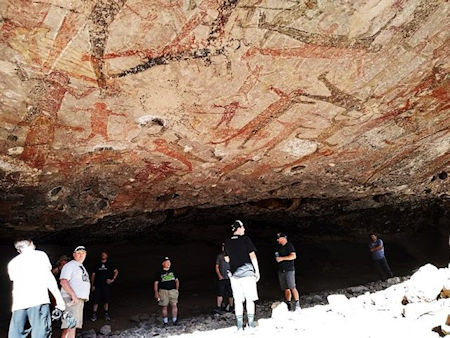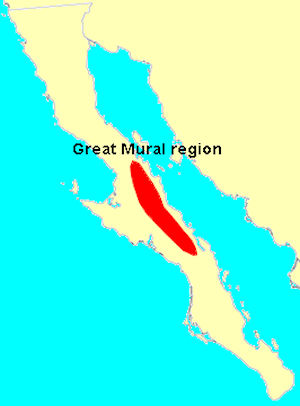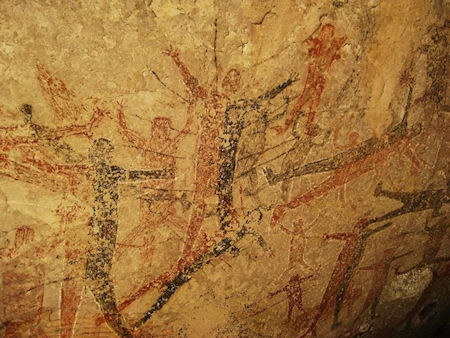 |  |

For close to a century, the enigmatic rock art adorning the secluded canyons and dramatic cliffs of Baja California has held a powerful allure for those adventurous enough to venture into its rugged embrace. To witness these ancient narratives etched in stone is no casual undertaking; it demands a commitment to traversing the peninsula's formidable terrain, a landscape sculpted by time and isolation. Yet, for those who heed the silent invitation, the arduous journey becomes a profound immersion into the mysteries held within the region's extraordinary cave paintings.
Far exceeding their European counterparts in both sheer number – with over 350 known sites – and often in the monumental scale of individual figures, these prehistoric murals represent an unparalleled artistic legacy on the American continent. For millennia, these treasures lay hidden within the remote sierras, their existence largely unknown to the wider world. Though whispers of their existence may have found their way into the records of early Spanish missionaries, these fleeting mentions did little to make their richness known to the world. It wasn't until the mid-20th century that the significance of this artistic treasure began to emerge into broader consciousness.
The very reason for the paintings' prolonged obscurity lies in the challenging geography of the Baja Peninsula. In this particular region, characterized by arid landscapes and a scarcity of surface water, survival dictated a close relationship with the mountainous interior. To find the life-sustaining resource of water, ancient inhabitants were compelled to follow precarious trails that snaked their way up into the high mountain country. The lowlands, while perhaps offering more accessible terrain for travel, were largely devoid of reliable water sources. Consequently, when the transpeninsular highway was eventually constructed, its path followed the most direct and convenient route through these arid lowlands. The mountains, the very heartland where precious water holes were located and where settlements could thrive year-round, remained the hidden sanctuaries that sheltered these remarkable artistic creations for millennia.

Among the earliest outsiders to actively explore and document this rock art were the members of the Meling expedition of 1963 and 1964. This ambitious undertaking, a grueling six-month journey aimed at traversing the entire length of the Baja Peninsula, offered some of the first recorded glimpses of the artistic treasures concealed within the mountainous interior. However, the primary objective of the expedition was to reach the southern tip of the peninsula, Cabo San Lucas. The unforgiving terrain of the Sierra, coupled with a severe multi-year drought that had drastically depleted food resources, presented the team with a difficult choice. They faced a critical decision: to venture further into the rugged Sierra in pursuit of the elusive rock art, or to prioritize their dwindling supplies and press onward towards their ultimate destination at Cabo. Ultimately, the exigencies of survival dictated their course, and they chose to continue their journey southward.
Despite the limitations of that early expedition, word of the remarkable paintings began to circulate. Since then, the rock art of Baja California has become the subject of dedicated study, meticulous photography, and insightful writings. Harry Crosby, a key figure in bringing this artistic heritage to wider recognition, learned of the significant sightings made by the Meling expedition. Following sound advice to "find a local guide," Crosby embarked on his own explorations into the remote canyons and mountainous regions. His seminal work, Cave Paintings of Baja California: Discovering the Great Murals of an Unknown People, stands as a testament to the extensive footwork and unwavering dedication he invested in reaching these isolated sites. Crosby brought much-needed attention and scholarly focus to these iconic artistic expressions, situated within what is often referred to as the "Grand Canyon of Baja," a dramatic landscape that holds a significant concentration of these ancient murals.
Initial estimations placed the age of these captivating artworks at around 2,000 years. Recent analyses suggest that some of these breathtaking creations could date back as far as 10,000 years, firmly establishing them amongst the oldest and most significant monumental art found anywhere on the continent. These awe-inspiring displays, often collectively referred to as the "Great Murals," dramatically entered popular consciousness in the United States following the publication of a captivating Life magazine article in 1962. The author was Erle Stanley Gardner, the celebrated mystery writer whose adventurous spirit led him to explore the remote corners of Baja.

The pivotal role of Gardner in bringing the Great Murals to the attention of a wider audience cannot be overstated. Driven by an insatiable curiosity, Gardner arranged to be flown into the rugged Sierra of Baja. As his small plane navigated the deep canyons, he caught sight of the remarkable paintings adorning the rock faces below. The impact of this aerial revelation was immediate and profound. Upon his return, Gardner, fueled by his discovery, enlisted the expertise of Clement Meighan, an archaeologist from the University of California, Los Angeles (UCLA). Together, they embarked on an expedition to the sites Gardner had glimpsed from above.
Gardner’s explorations not only resulted in the widely read article but also in his book, The Hidden Heart of Baja. Gardner cemented the connection between the dramatic, untamed landscapes of Baja and its profound, enigmatic artistic heritage.
In those early days of exploration, simply reaching the cave painting sites often involved arduous journeys spanning multiple days, with travelers often camping under the vast desert skies along the way. The very ruggedness of the experience served as a powerful connection to the raw beauty and demanding nature of the landscape, almost as a form of ritualistic preparation for entering these artistic sanctuaries, places where the echoes of the past resonated deeply within the silence.
Each cave site, it becomes apparent upon closer examination, possesses its own distinct character, its own unique atmosphere. One might draw a parallel to the diverse chapels within a grand cathedral, each perhaps dedicated to a particular aspect of belief or a specific narrative. The sheer scale of some of the paintings, particularly within prominent sites like Cueva Pintada, is often enough to inspire profound awe in the observer, leaving an indelible impression of the artistic ambition and skill of their creators. As is often the case in mythic storytelling across cultures, many of the most significant figures depicted in these murals are rendered in proportions that dwarf human scale, suggesting their importance within the cosmology and beliefs of the ancient people who created them.

However, beyond the impressive scale and the sheer antiquity, perhaps the most enduring and captivating allure of Baja California's cave paintings lies in their profound potential to communicate across the vast chasm of time that separates us from their creators. Standing before these silent narratives etched onto the rock, one cannot help but ponder the fundamental questions they evoke: What stories were these ancient artists trying to tell? What was the purpose of these artistic endeavors, and why were these particular locations chosen? What significance can be gleaned from their orientation, the direction they face, or the specific figures and motifs they include? The remarkable height at which some of these paintings are located – with examples soaring dozens of feet above the cave floor – raises intriguing questions about the techniques and possible scaffolding employed by these prehistoric artists. Furthermore, the dynamic compositions, predominantly rendered in striking red and black pigments, offer tantalizing glimpses into the daily lives, beliefs, and complex cosmology of the prehistoric people who painted them. The recurring motifs of human figures, often adorned with elaborate and stylized headdresses, alongside the abundant depictions of deer and other animals, hint at a deep connection to the natural world and the spiritual beliefs that intertwined human existence with the surrounding environment.
An intimate knowledge of the land, honed by decades of firsthand exploration and a deep respect for its rich history, continues to illuminate the silent narratives etched in stone, offering invaluable insights into the minds, lives, and artistic expressions of the people who left behind this remarkable and enduring artistic legacy.
Photos courtesy of David Kier.
Great Mural map courtesy of Wikimedia.

Convenient, great website, prices are reasonable.

Fair price. Webpage could be improved.

Great price and really easy to buy coverage online. However, you never really know how good the...